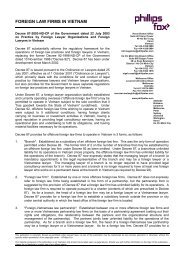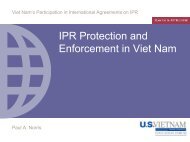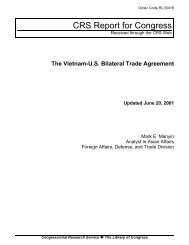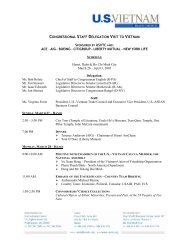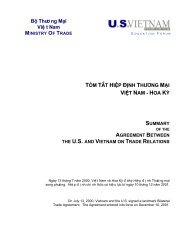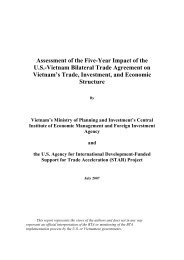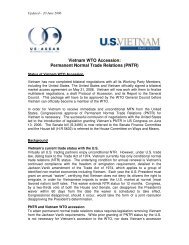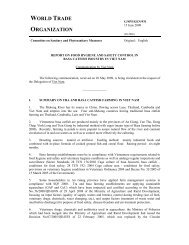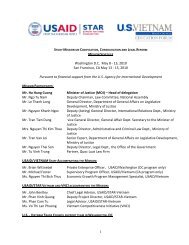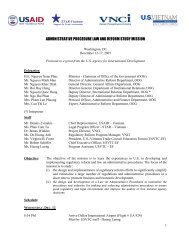Table 4.12 ■ Investment Costs <strong>and</strong> Net Present Value of Benefits Associated withDifferent Flood Control Projects <strong>in</strong> Manila (PHP) us<strong>in</strong>g a 15 percentdiscount rate (Cont<strong>in</strong>ued)1/10 Flood 1/30 Flood 1/100 Flood<strong>Climate</strong> Scenario Investment Cost NPV Investment Cost NPV Investment Cost NPVA1FI A1FI-EX wD NA 14,248,304,696 7,092,797,122 13,640,673,269 12,011,488,435A1FI-EX nD 1,409,166,226 (581,704,127) 11,099,925,438 9,203,568,238 NAA1FI MP wD NA 3,216,390,949 5,509,802,569 139,119,548 10,411,715,022A1FI MP nD NA 68,011,692 7,620,573,684 NASource: Muto et al. (2010).SQ=Status Quo, EX=Exist<strong>in</strong>g Infrastructure, B1, A1FI=<strong>Climate</strong> Change Scenarios, wD=With Marik<strong>in</strong>a Dam, nD=No Dam, NA=not applicable. Costs are 0 <strong>in</strong> certa<strong>in</strong> cases because it isassumed that these costs are <strong>in</strong>corporated <strong>in</strong> the master plan.count rate of 15 percent, which is what is used by thePhilipp<strong>in</strong>es National Economic <strong>and</strong> Developmentauthority to estimate project feasibility. 55Dam construction emerges as aneconomically viable option <strong>in</strong> both climatechange scenarios, followed by embankmentbuild<strong>in</strong>g <strong>in</strong> the Pasig-Marik<strong>in</strong>a bas<strong>in</strong>Table 4.12 presents the present value of net benefitsfrom different <strong>in</strong>vestments considered. The NPVat12 billion PHP ($269 million) is highest among allthe different scenarios. This suggests that construct<strong>in</strong>gthe Marik<strong>in</strong>a Dam would maximize benefitsrelative to other <strong>adaptation</strong> options <strong>in</strong> the case ofan A1FI or B1 scenario. The <strong>in</strong>vestments that wouldbe required <strong>in</strong> this scenario are build<strong>in</strong>g the Pasig-Marik<strong>in</strong>a River bas<strong>in</strong> embankment, the Marik<strong>in</strong>aDam, <strong>and</strong> some additional embankments along thePasig <strong>and</strong> Marik<strong>in</strong>a rivers. These <strong>in</strong>vestments wouldlargely elim<strong>in</strong>ate floods <strong>in</strong> this part of Metro Manila.However, given that construct<strong>in</strong>g the dam is adecision that may or may not be taken, it is usefulto consider what alternative options emerge. In thiscase, <strong>in</strong> an A1FI scenario it is recommended that thePasig Marik<strong>in</strong>a River embankment be built withsome additional components along the Pasig <strong>and</strong>Marik<strong>in</strong>a rivers, <strong>and</strong> that storm surge barriers beconstructed. This basically means that <strong>in</strong>vestmentsunder the current master plan <strong>in</strong> the Pasig-Marik<strong>in</strong>aRiver bas<strong>in</strong> should be prioritized <strong>and</strong> cont<strong>in</strong>ued <strong>and</strong>some additional <strong>in</strong>vestments need to be made forFigure 4.9 ■ Annual Benefits fromAdaptation Investments <strong>in</strong>Metro ManilaDamage cost (PHP <strong>in</strong> million)120,000100,00080,00060,00040,00020,00000.00 0.02 0.04 0.06 0.08 0.10ProbabilityExist<strong>in</strong>g <strong>in</strong>frastructure(EX)1990 master plan level(MP)Source: Based on estimations <strong>in</strong> Muto et al. (2010).Full <strong>adaptation</strong>levelfull <strong>adaptation</strong> to an A1FI climate. This is what iscurrently be<strong>in</strong>g undertaken by the government ofthe Philipp<strong>in</strong>es <strong>in</strong> implement<strong>in</strong>g the Pasig-Marik<strong>in</strong>aFlood Control Project Phase II to avoid damages fromP30 floods. The recommendations <strong>in</strong> the context ofa B1 climate change scenario are similar. In sum,the first priority is to control flood<strong>in</strong>g <strong>in</strong> the Pasig-55It is important to note that the total avoided damages(gross) <strong>in</strong> chapter 3 do not directly feed <strong>in</strong>to the NPV calculations.This is because there are three geographical areas,<strong>and</strong> depend<strong>in</strong>g on the return period <strong>and</strong> <strong>adaptation</strong> <strong>in</strong>vestments,only the relevant benefits are considered for eachscenario. (For example, the embankment for Pasig-Marik<strong>in</strong>aRiver does not affect KAMANAVA <strong>coastal</strong> area <strong>and</strong> thereis thus no benefit <strong>in</strong> that area).68 | <strong>Climate</strong> Risks <strong>and</strong> Adaptation <strong>in</strong> <strong>Asian</strong> Coastal Megacities: A Synthesis Report
Marik<strong>in</strong>a River areas through a dam, embankments,<strong>and</strong> storm surge barriers. While <strong>adaptation</strong> to climatechange would require significant <strong>in</strong>vestments, <strong>in</strong> thecase of Metro Manila, these are <strong>in</strong>vestments that arealready planned. Thus, climate change <strong>adaptation</strong>would require the government to commit to implement<strong>in</strong>gplans that are currently on the books.Analysis of Damage Costs <strong>in</strong>HCMCHCMC has a long history of extreme weather events.Between 1997 <strong>and</strong> 2007, almost all of the districts ofHo Chi M<strong>in</strong>h City have been directly affected bynatural disasters to some extent. The total value ofdamage to property from natural disasters over thelast 10 years is estimated at over $12.6 million (202billion VND). Most impacts have been concentrated<strong>in</strong> the predom<strong>in</strong>antly rural Can Gio <strong>and</strong> Nha Bedistricts. However, with <strong>in</strong>creased levels of flood<strong>in</strong>g<strong>and</strong> extreme events due to climate change, urbanareas are likely to suffer <strong>in</strong>creas<strong>in</strong>g levels of damage.This is likely to <strong>in</strong>crease costs significantly.The HCMC study used a different approachfrom Bangkok <strong>and</strong> Manila to estimate the aggregatecosts of climate change impacts to 2050. It does nottake a sectoral approach <strong>and</strong> estimate <strong>in</strong> detail thecosts that will be <strong>in</strong>curred as a result of climatechange. While areas of vulnerability <strong>and</strong> <strong>risks</strong> areclear, there has been no attempt to value specific<strong>risks</strong> directly. Rather, a first approximation of thelikely costs of climate change is undertaken basedon macro data. Further, the HCMC study estimatesthe present value of flood<strong>in</strong>g from the current periodup to 2050. Thus, it presents cost estimates todaythat reflect repeated flood<strong>in</strong>g over a long period oftime. In contrast, the Manila <strong>and</strong> Bangkok studiesestimate the costs of specific s<strong>in</strong>gle events of flood<strong>in</strong>g<strong>in</strong> different scenarios.As discussed <strong>in</strong> chapter 2, the HCMC studyuses two approaches to estimate the costs of climatechange: (1) cost estimates based on expected lostl<strong>and</strong> values; <strong>and</strong> (2) cost estimates based on aggregateGDP loss. To recap briefly, the l<strong>and</strong> valuemethod estimates how climate change may affectthe value of the l<strong>and</strong> stock <strong>in</strong> HCMC. The first step<strong>in</strong> the analysis was to determ<strong>in</strong>e l<strong>and</strong> prices. Thearea subject to flood<strong>in</strong>g both <strong>in</strong> extreme events<strong>and</strong> regular flood<strong>in</strong>g was then determ<strong>in</strong>ed underfuture scenarios us<strong>in</strong>g HydroGIS model<strong>in</strong>g. Onceaverage l<strong>and</strong> price <strong>and</strong> flood<strong>in</strong>g extent <strong>and</strong> durationwere estimated, the relationship between theflood<strong>in</strong>g <strong>and</strong> the decl<strong>in</strong>e <strong>in</strong> the economic value ofthe flooded l<strong>and</strong> was determ<strong>in</strong>ed to calculate thecost of flood<strong>in</strong>g due to climate change. The valueof l<strong>and</strong> affected by flood<strong>in</strong>g is assessed assum<strong>in</strong>gl<strong>in</strong>ear <strong>and</strong> quadratic relationships between floodduration <strong>and</strong> l<strong>and</strong> values. The second approachused by HCMC is to calculate costs on the basis ofexpected losses <strong>in</strong> production (proxied by GDP) dueto climate-change-<strong>in</strong>duced flood<strong>in</strong>g. For each district<strong>and</strong> for each year (2006 to 2050), the annual costof flood<strong>in</strong>g was calculated <strong>and</strong> the discounted costssummed for the whole period to f<strong>in</strong>d the presentvalue of expected lost GDP. In the follow<strong>in</strong>g pages<strong>and</strong> the rest of this report, an average exchange ratefor 2008 of 1 USD = 16302.25 VND is used to convertVietnamese dong to U.S. dollars.Macro level analyses suggest that there willbe significant costs as a result of climatechangeThe study estimates that the losses <strong>in</strong> the economicvalue of l<strong>and</strong> affected by 2050 climate change wouldrange from VND 100,358 billion ($6.15 billion) forregular flood<strong>in</strong>g to VND 6,905 billion ($0.42 billion)for extreme flood<strong>in</strong>g, assum<strong>in</strong>g a quadraticrelationship between flood duration <strong>and</strong> l<strong>and</strong> value(Table 4.13). 56 The HCMC study also reports climatechange costs assum<strong>in</strong>g a l<strong>in</strong>ear relationshipbetween flood duration <strong>and</strong> l<strong>and</strong> values. In thiscontext, the cost of climate change is estimated tobe VND 369,377 billion ($22.7 billion) for regularfloods <strong>and</strong> VND 111,678 billion ($6.9 billion) forextreme events. The highest costs (us<strong>in</strong>g either method)are borne by B<strong>in</strong>h Chanh district, district 9, Can Gio,<strong>and</strong> Nha Be district.56In all estimates, the costs of extreme events are muchsmaller than those of regular flood<strong>in</strong>g because (a) flood<strong>in</strong>gdue to extreme events lasts for a smaller number of daysthan that for regular flood<strong>in</strong>g; <strong>and</strong> (b) the calculation offlood<strong>in</strong>g assumes a return period of 30 years for extremeflood<strong>in</strong>g. The expected value <strong>in</strong> any given year is therefore1/30th of the cost of an extreme event.Assess<strong>in</strong>g Damage Costs <strong>and</strong> Prioritiz<strong>in</strong>g Adaptation Options | 69



